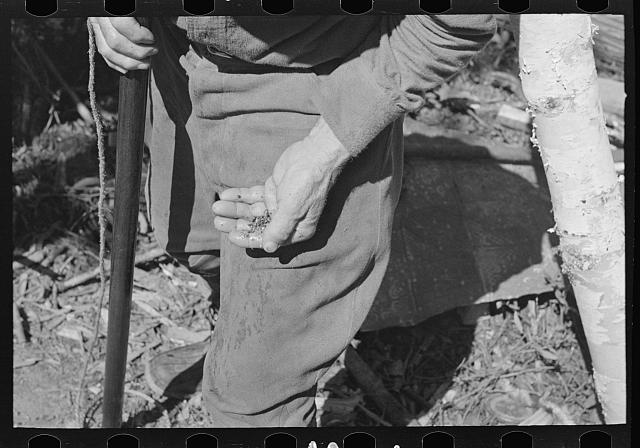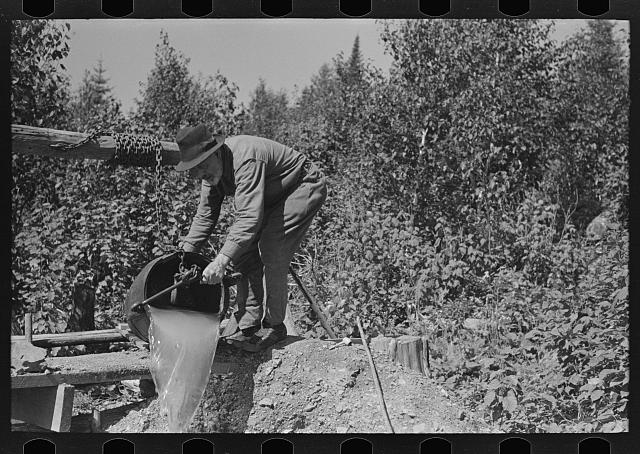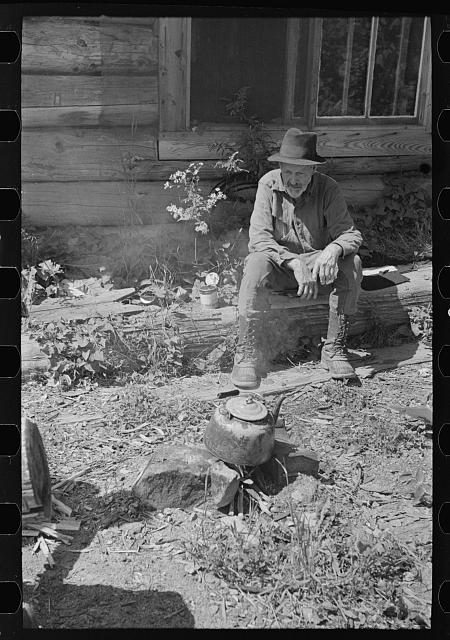I love this photo. I chose it because I love it, and I wanted to recover it from the depths of the Library of Congress archive. I want to redeem this photo from Stryker’s harsh hand and resurrect the image from where he tried to bury it when he chose to kill the negative.
Like all of the other killed negatives in this digital essay, I came across this one by change. It is not possible to search directly for killed negatives in the Library of Congress archive because they are not key-worded, but they will occasionally surface in searches if they have been parenthetically-titled based the images that surround them by call number. All we know for certain about this photograph is that it was taken by Russell Lee. The most productive of the FSA photographers, Lee produced more than 5000 photos during his time with the department. Because of his ability to capture all of the details of a particular subject, Lee was described by Stryker as a “taxidemist with a camera” (Wetzel 259). His interest in detail was accentuated by his practice; unlike other FSA photographers, like Dorothea Lange, who preferred natural light and rarely worked indoors, Lee frequently used direct flash and many of his most well known photos were taken within his subjects’ homes (Morgan).
Beyond knowing Lee to be the photographer, we are left only with inference to determine the subject and details of this image. Based on surrounding photos, the man in the image is William Besson, a mining prospector who lived near Winton, Minnesota. The image was taken in September 1937. Besson leans over a homemade windlass, a type of winch used to lower buckets into and hoist them up from wells. His fingers dangle, draped over the rough wood. They resemble the chain, wrapped around the wind-shaft; they are working fingers. When Lee captured the image, the chain and Besson’s fingers would have been less than a food apart, and yet now they are separated by a gaping black abyss. Stryker punch precisely through the center of the negative. It is so perfectly aligned that it is, thankfully, easier for the eye to pass over than in other killed negatives.

[Untitled photo, possibly related to: William Besson, mining prospector, near Winton, Minnesota. The windlass is homemade]
Perhaps what I love in this photo, beyond Lee’s attention to detail, is how his social conscious peaks through into this image. Lee’s was a social consciousness born not out of politics, like the FSA, but out of his conviction and concern that “people were do damned poor” (Wetzel 260). Roy Stryker would would occasionally accompany Lee when he traveled for the FSA. Stryker recounted his observations of Lee on one of these trips to Richard K. Doud, in 1963 (qtd in Wetzel 261):
We saw a very curious, very nice looking little old lady with her hair done in a little top knot and . . . Russell [Lee] said to her, “may we take your picture?” And she bristled, “what do you want my picture for?” “Well we’re with the government.” “Oh you’re with the government. Well, I don’t want you to take my picture.” He said, “well, now look. There’s a lot of people think (sic) that you represent a bunch of lazy good-for-nothings. We don’t think so. And we’d like to tell ‘em a little bit more about who you are, what you’re (sic) problems are.” It got her intrigued and she started to talk.
Unlike most of his FSA Colleagues, Lee produced his photos as series, creating narratives rather than seeking out a single great image. Morgan argues that, as a result, “Lee’s photographs were understated, as he carefully documented the scenes he encountered” (Morgan). This image is part of a series of thirty-two photographs that Lee captured of William Besson, and one of approximately 72 photos Lee took in Winton. These photos are also part of the narrative Lee created of Benson’s life:

A handful of rock from drilling operations of William Besson, mining prospector, near Winton, Minnesota
The Untitled photo of Besson clearly bares the mark of Stryker’s rejection. Perhaps it was too similar to other photos in the series, or perhaps it simply did not fit by Stryker’s criteria. But, it fits here – rejected photos resurrected.
Wetzel, Alissa C. “New Deal Photographs of the Hoosier State Farm Tenancy, the Great Depression and the Young Girl Who Lived Through It All.” Indiana Magazine of History 109 (2013): 257-74.
Young, Morgan. “Russell Lee.” Densho Encyclopedia. N.d. Web. 25 Apr. 2016. <http://encyclopedia.densho.org/Russell_Lee/3>.
United States Resettlement Administration, photographer by Lee, Russell. [Untitled photo, possibly related to: William Besson, mining prospector, near Winton, Minnesota. The windlass is homemade]. [Sept, 1937] Image. Retrieved from the Library of Congress, <https://www.loc.gov/item/fsa1997021951/PP>.
United States Resettlement Administration, photographer by Lee, Russell. William Besson dumping water from shaft near Winton, Minnesota. Sept, 1937. Image. Retrieved from the Library of Congress, <https://www.loc.gov/item/fsa1997021953/PP>.
United States Resettlement Administration, photographer by Lee, Russell. William Besson, old mining prospector, near Winton, Minnesota. Sept, 1937. Image. Retrieved from the Library of Congress, <https://www.loc.gov/item/fsa1997021924/PP>.
United States Resettlement Administration, photographer by Lee, Russell. A handful of rock from drilling operations of William Besson, mining prospector, near Winton, Minnesota. Sept, 1937. Image. Retrieved from the Library of Congress, <https://www.loc.gov/item/fsa1997021914/PP>.

